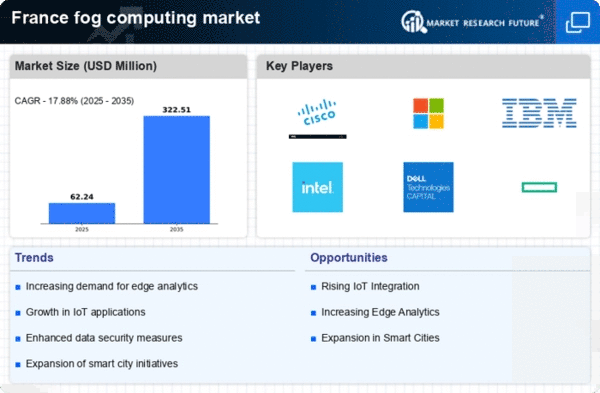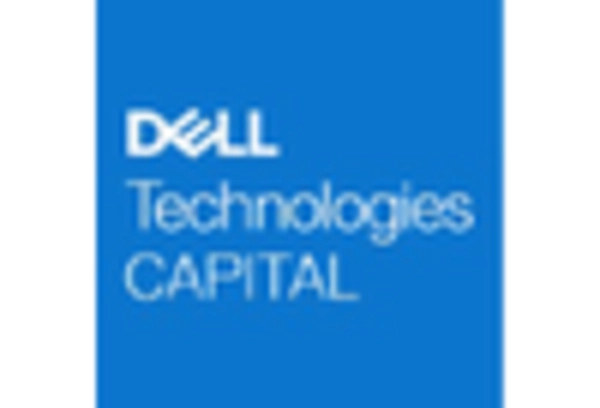Growth of IoT Applications
The proliferation of Internet of Things (IoT) applications is significantly influencing the fog computing market in France. As more devices become interconnected, the need for efficient data processing and management at the edge becomes increasingly apparent. Fog computing provides a framework that allows for the processing of data closer to the source, thereby minimizing latency and enhancing the performance of IoT applications. In France, the number of IoT devices is expected to reach over 1 billion by 2026, creating a substantial demand for fog computing solutions. This growth is likely to drive investments in infrastructure and services that support the fog computing market, as organizations seek to leverage the benefits of real-time data analytics and improved operational efficiency. Consequently, the fog computing market is well-positioned to capitalize on the expanding IoT ecosystem, which is becoming a cornerstone of modern technological advancements.
Government Initiatives and Support
In France, government initiatives aimed at promoting digital transformation are playing a crucial role in the expansion of the fog computing market. The French government has launched several programs to encourage the adoption of advanced technologies, including fog computing, as part of its broader strategy to enhance the country's technological infrastructure. These initiatives often include funding opportunities, tax incentives, and support for research and development. For instance, the French Digital Agency has been instrumental in fostering innovation within the tech sector, which indirectly boosts the fog computing market. As a result, businesses are more likely to invest in fog computing solutions, knowing that they have the backing of governmental support. This environment not only stimulates market growth but also encourages collaboration between public and private sectors, further solidifying the position of fog computing in France's digital landscape.
Advancements in Network Infrastructure
The ongoing advancements in network infrastructure are significantly impacting the fog computing market in France. The rollout of 5G technology is particularly noteworthy, as it promises to enhance connectivity and enable faster data transmission. This improved network capability is essential for the effective implementation of fog computing solutions, which rely on low-latency communication and high bandwidth. As 5G networks become more prevalent, the fog computing market is likely to experience accelerated growth, as businesses leverage these advancements to optimize their operations. Furthermore, the integration of technologies such as Software-Defined Networking (SDN) and Network Function Virtualization (NFV) is expected to facilitate the deployment of fog computing architectures. These developments not only enhance the performance of fog computing solutions but also broaden their applicability across various sectors, thereby driving market expansion.
Need for Enhanced Data Privacy Regulations
The fog computing market in France is also shaped by an increasing emphasis on data privacy. Compliance with regulations is becoming essential. With the implementation of stringent data protection laws, such as the General Data Protection Regulation (GDPR), organizations are compelled to adopt solutions that ensure data security and privacy. Fog computing offers a viable approach by enabling data processing at the edge, which can help mitigate risks associated with data breaches and unauthorized access. By keeping sensitive data closer to its source, businesses can enhance their compliance with regulatory requirements while also improving their overall data management strategies. This focus on data privacy is likely to drive the adoption of fog computing solutions, as organizations seek to align their operations with legal standards while maintaining customer trust. Thus, the fog computing market stands to gain from the heightened awareness and necessity for robust data protection measures.
Rising Demand for Edge Computing Solutions
The fog computing market in France is experiencing a notable surge in demand for edge computing solutions. This trend is driven by the increasing need for real-time data processing and analysis, particularly in sectors such as manufacturing and transportation. As organizations seek to enhance operational efficiency, the integration of fog computing technologies allows for localized data processing, reducing latency and bandwidth usage. According to recent estimates, the edge computing segment is projected to grow at a CAGR of approximately 25% over the next five years. This growth is indicative of the broader shift towards decentralized computing architectures, which are essential for supporting the evolving needs of various industries. Consequently, the fog computing market is poised to benefit significantly from this rising demand, as businesses prioritize solutions that enable faster decision-making and improved service delivery.

















Leave a Comment